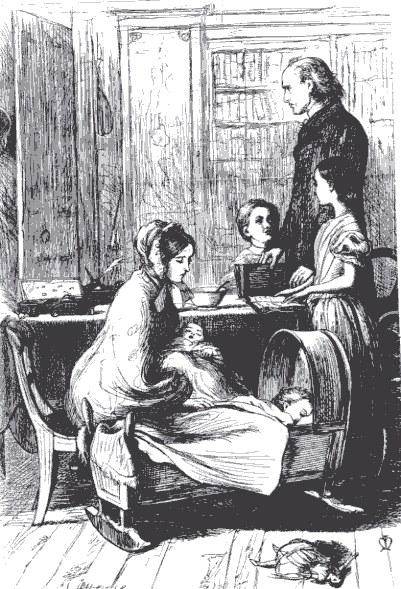- 'Lord Lufton and Lucy Robarts'. Source: 1996 Trollope Society edition
of Framley Parsonage, facing p. 111; also reprinted Hennessey,
p. 99; Snow, p. 116. Reprinted and discussed repeatedly in many texts on Trollope's novels. See especially N. John Hall, Anthony
Trollope and His Illustrators, pp. 12-13; Hilary Gresty, 'Millais
and Trollope: Author and Illustrator', The Book Collector, 1981
(30), pp. 46-54.
 John Everett Millais, "Lord Lufton and Lucy Robarts"
John Everett Millais, "Lord Lufton and Lucy Robarts"
- 'Was it not a lie?'. Source: 1996 Trollope Society Framley
Parsonage, facing p. 168; also reprinted Hennessy, p. 97; Margaret
Markwick, Trollope and Women, p. 24. Also repeatedly reprinted and discussed in books on Trollope's novels; again see Hall, AT and His Illustrators, pp. 14-18; Gresty,
'Millais and Trollope: Author and Illustrator', pp. 46-54.
 John Everett Millais, "'Was it not a lie?'" [Lucy on bed crying]
John Everett Millais, "'Was it not a lie?'" [Lucy on bed crying]
- 'The Crawley Family'. Source: 1996 Trollope Society edition
of Framley Parsonage, facing p. 222. Very good reprint of
print and plate in 'English Illustrators in the Collection of George
Arents', em>The Colphon, Series 3, No. 4 (1940), pp. 8-9;
also reprinted Hennessy, p. 199. Repeatedly printed and discussed:
Hall, AT and His Illustrators, pp. 18-21; Gresty, 'Millais
and Trollope: Author and Illustrator', pp. 46-54:
 John Everett Millais, "The Crawley Family"
John Everett Millais, "The Crawley Family"
It is a vivid depiction; George Housman Thomas kept to Millais's conconception so we see the same figure growing old in Last Chronicle of Barset.
- 'Lady Lufton and the Duke of Omnium'. Source 1996 Trollope Society
edition of Framley Parsonage, facting p 296. Reprinted and
discussed: Hall, AT and His Illustrators, pp. 21-24;
Gresty, 'Millais and Trollope: Author and Illustrator', pp.
46-54:
 John Everett Millais, "Lady Lufton and the Duke of Omnium"
John Everett Millais, "Lady Lufton and the Duke of Omnium"
This is an effective group scene. It makes visible the underlying caste-ridden values of the behavior of Trollope's characters in such parties. Trollope's fundamental sceptical and disillusioned attitude towards the "pleasures" of partying may be found in his New Zealander. We might call this (debunkingly) the top lady meets the top moral man. Millais's drawing gets the feeling of Lady Lufton's reluctance to bow before this man she disdains.
- 'Mrs Gresham and Miss Dunstable'. Source: 1996 Trollope Society edition
of Framley Parsonage, facing p. 390. Reprinted Hall,
AT and His Illustrators, pp. 22. The picture is
still; there's a (probably unintended) snobbish look on Mary's face; however Mrs Dunstable has some life even from the back
 John Everett Millais, detail from "Mrs Gresham and Miss Dunstable'" (Miss Dunstable thinking]
John Everett Millais, detail from "Mrs Gresham and Miss Dunstable'" (Miss Dunstable thinking]
- '"Mark", she said, "the men are here"'. Source: 1996 Trollope
Society edition of Framley Parsonage, facing p. 450; also
reprinted in Markwick, Trollope and Women, p. 25; cover
illustration to 1984 Penguin Framley Parsonage, edited
by David Skilton and Peter Miles. Reprinted and discussed: Hall,
AT and His Illustrators, pp. 23-26:
 John Everett Millais, Fanny and Mark Robarts
John Everett Millais, Fanny and Mark Robarts
This is a moral paradigm. Trollope himself had experienced such a scene when a boy. Though the atmosphere he described was much less solemn, with him and his sisters ferrying items across a fence to a neighbor, the humiliation stayed with him.





